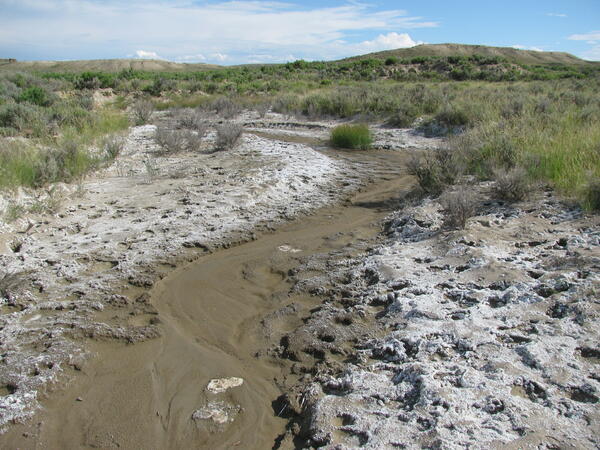Cells used to isolate a fish virus die when infected with the picornavirus.
Images

Cells used to isolate a fish virus die when infected with the picornavirus.
Sampling well network at Fourmile Creek, Iowa. The Ankeny Waterwater Treatment Plant discharge can be seen in background on the opposite bank. The water in the stream is flowing toward viewer.
Sampling well network at Fourmile Creek, Iowa. The Ankeny Waterwater Treatment Plant discharge can be seen in background on the opposite bank. The water in the stream is flowing toward viewer.

A bloom of cyanobacteria near the shore of Milford Lake, Kansas
A bloom of cyanobacteria near the shore of Milford Lake, Kansas

USGS scientists prepare a sampler used to measure emission of polycyclic aromatic carbons (PAHs) into the air.
USGS scientists prepare a sampler used to measure emission of polycyclic aromatic carbons (PAHs) into the air.

A professional applicator applies coal-tar-based sealcoat to a test plot used to measure emission of polycyclic aromatic carbons (PAHs) into the air.
A professional applicator applies coal-tar-based sealcoat to a test plot used to measure emission of polycyclic aromatic carbons (PAHs) into the air.

A USGS scientist adjusts an air pump used to measure emission of polycyclic aromatic carbons (PAHs) into the air.
A USGS scientist adjusts an air pump used to measure emission of polycyclic aromatic carbons (PAHs) into the air.

White crusts of natural salts along a tributary to Muddy Creek, Wyoming. Natural salts are present in soils from drier climates, and rain and snowmelt can percolate into the soil and carry the salts to streams.
White crusts of natural salts along a tributary to Muddy Creek, Wyoming. Natural salts are present in soils from drier climates, and rain and snowmelt can percolate into the soil and carry the salts to streams.
New section of a landfill under construction
New section of a landfill under construction

USGS scientist sampling groundwater from a well for contaminants of emerging concern, Minnesota.
USGS scientist sampling groundwater from a well for contaminants of emerging concern, Minnesota.
Scientists study tree swallows (Tachycineta bicolor) in the Great Lakes region to determine chemical exposure, physiological response, and reproductive success.
Scientists study tree swallows (Tachycineta bicolor) in the Great Lakes region to determine chemical exposure, physiological response, and reproductive success.

Wetland habitats, such as the Great Salt Lake wetlands, provide critical feeding areas for many fish and wildlife species.
Wetland habitats, such as the Great Salt Lake wetlands, provide critical feeding areas for many fish and wildlife species.
A typical tree swallow (Tachycineta bicolor) in the Great Lakes area. Tree swallows were studied by the scientists for contaminants in the eggs.
A typical tree swallow (Tachycineta bicolor) in the Great Lakes area. Tree swallows were studied by the scientists for contaminants in the eggs.

A typical tree swallow (Tachycineta bicolor) studied by the scientists.
A typical tree swallow (Tachycineta bicolor) studied by the scientists.

Organic Chemistry Research Laboratory — Sacramento, California. USGS chemist working with samples in a laboratory hood
Organic Chemistry Research Laboratory — Sacramento, California. USGS chemist working with samples in a laboratory hood

Organic Chemistry Research Laboratory — Sacramento, California. USGS chemist homogenizes a tissue sample into a mortar and pestle
Organic Chemistry Research Laboratory — Sacramento, California. USGS chemist homogenizes a tissue sample into a mortar and pestle

A U.S. Geological Survey (USGS) scientist collecting a liver tissue sample from a wild-caught white sucker (Catostomus commersonii) from a river in the Great Lakes area.
A U.S. Geological Survey (USGS) scientist collecting a liver tissue sample from a wild-caught white sucker (Catostomus commersonii) from a river in the Great Lakes area.
Body surface tumor diagnosed as a squamous cell carcinoma on a white sucker fish
Body surface tumor diagnosed as a squamous cell carcinoma on a white sucker fish

A lip tumor diagnosed as a papilloma on a white sucker (Catostomus commersonii) collected from the Milwaukee River.
A lip tumor diagnosed as a papilloma on a white sucker (Catostomus commersonii) collected from the Milwaukee River.

Dairy cows in an animal feeding operation in New York
Dairy cows in an animal feeding operation in New York
Remnants of a spruce forest complex following a severe wildfire in the Yukon Flats National Wildlife Refuge, Alaska. Wildfires are the dominant landscape-scale disturbance operating at annual time scales in Alaska, and fires play a major role in the rate and extent of vegetation growth and productivity of a site.
Remnants of a spruce forest complex following a severe wildfire in the Yukon Flats National Wildlife Refuge, Alaska. Wildfires are the dominant landscape-scale disturbance operating at annual time scales in Alaska, and fires play a major role in the rate and extent of vegetation growth and productivity of a site.

Cedar Creek in Congaree National Park, SC, showing old growth bottomland hardwood forest
Cedar Creek in Congaree National Park, SC, showing old growth bottomland hardwood forest







